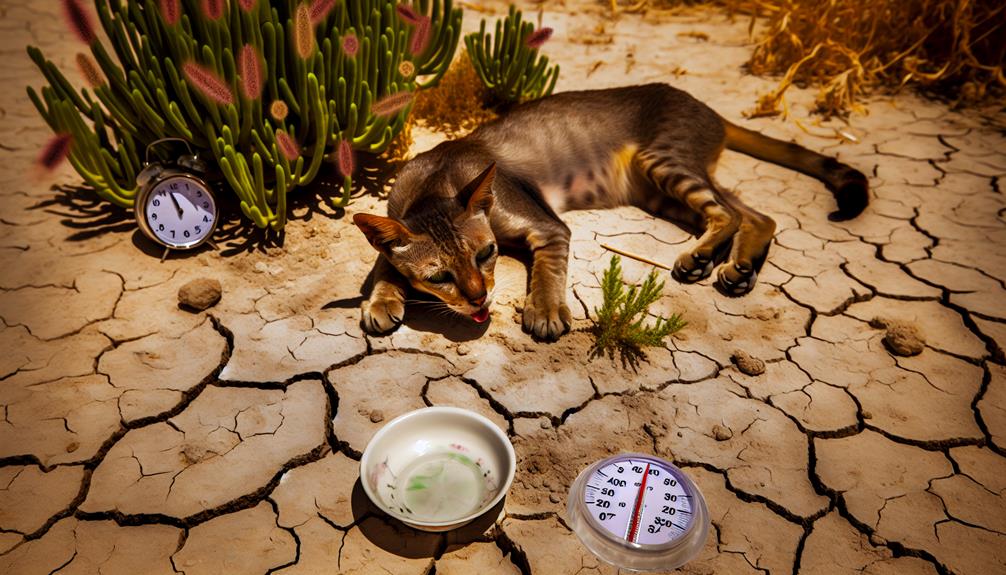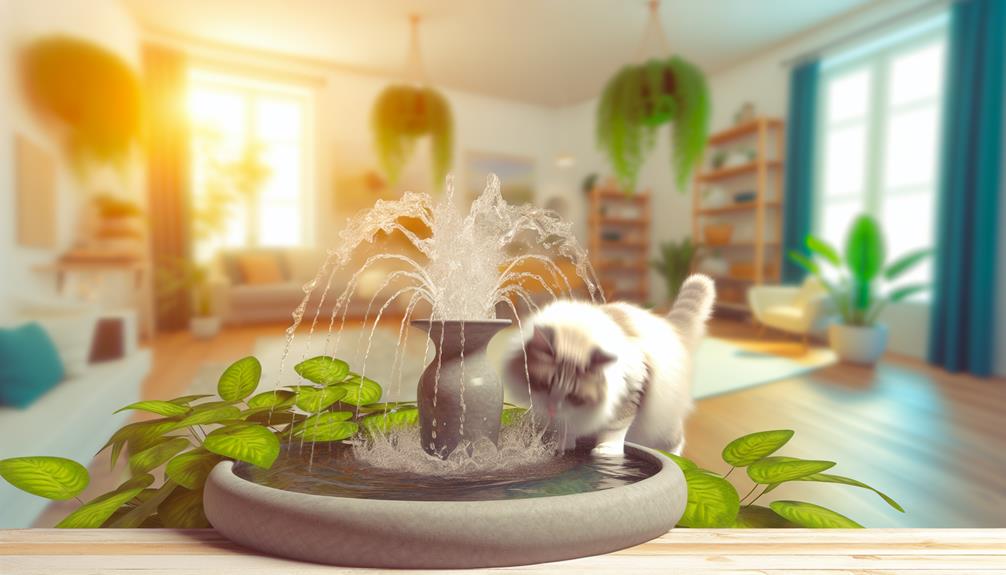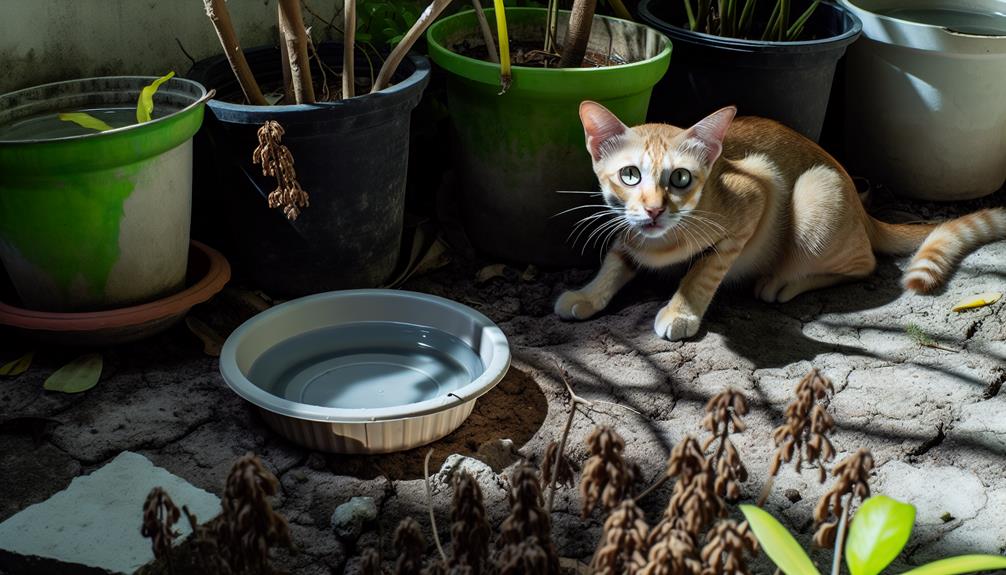You might wonder just how long your cat can go without water before it becomes a serious concern. While generally, cats can survive around three to four days without hydration, various factors like age, health, and environmental conditions can alter this timeframe. Even a day without water can potentially lead to health complications such as kidney damage or urinary tract issues. Ensuring your cat has access to fresh water is essential, but what are the telltale signs of dehydration and how can you encourage your cat to drink more? Let's explore further.
Importance of Hydration
Hydration is paramount to a cat's health, affecting nearly every physiological process. Adequate hydration benefits include ideal kidney function, efficient nutrient transportation, and temperature regulation. Cats, being obligate carnivores, have evolved to derive much of their water intake from their prey, which typically consists of about 70-75% water. However, domesticated cats often rely on various water sources to meet their hydration needs.
It's essential to understand these sources and their impacts. Wet cat food, for example, contains approximately 75-80% water, closely mimicking the hydration levels found in natural prey. Conversely, dry food offers only about 10% water, necessitating an increased intake of fresh water to compensate. Encouraging your cat to drink from a bowl or a water fountain can greatly support their hydration status.
Lack of proper hydration can lead to severe health issues such as urinary tract infections, kidney stones, and chronic renal failure. Dehydration impairs cellular function and can exacerbate pre-existing conditions like diabetes mellitus and hyperthyroidism. Monitoring your cat's water intake and ensuring they have access to clean, fresh water at all times is critical.
You might notice that some cats are finicky about their water sources. They may prefer running water or specific types of bowls. Observing these preferences and accommodating them can enhance their water consumption. Additionally, incorporating water-rich foods into their diet can provide considerable hydration benefits. By understanding and facilitating proper hydration, you're proactively supporting your cat's overall health and well-being.
Typical Water Needs
When considering your cat's typical water needs, it's important to recognize that daily requirements can vary based on factors such as age, weight, diet, and overall health. A healthy adult cat typically requires approximately 3.5-4.5 ounces of water per 5 pounds of body weight each day. This translates to an average water consumption of around 7-9 ounces daily for a cat weighing 10 pounds.
The type of diet your cat consumes considerably affects their water intake. Cats on a dry food diet will need to drink more water compared to those on a wet food diet, as wet food contains approximately 70-80% moisture. Conversely, dry food only contains about 10% moisture, necessitating higher supplementary water consumption.
Monitoring your cat's water intake is essential for making certain they meet their daily requirements. Inadequate water consumption can lead to dehydration, which poses severe health risks. Cats have a naturally low thirst drive, so they may not drink sufficient water on their own, especially if they are consuming a dry food diet. Providing fresh, clean water at all times is imperative, and consider using a cat water fountain to encourage drinking, as cats often prefer running water.
Certain health conditions, such as kidney disease or diabetes, can also alter your cat's water needs, increasing their daily requirements. Regular veterinary check-ups can help monitor their health status and adjust their water consumption accordingly. Understanding and meeting your cat's typical water needs through vigilant observation and appropriate dietary choices can promote their overall well-being and help prevent potential health issues.
Factors Affecting Dehydration

Understanding your cat's typical water needs provides a foundation for recognizing the factors affecting dehydration. It's essential to understand that several variables can influence how quickly a cat becomes dehydrated. Age factors prominently impact water requirements and susceptibility to dehydration. Kittens and elderly cats are particularly vulnerable due to their developing or declining physiological functions. Kittens may not consume adequate water independently, while older cats often have diminished thirst signals and renal efficiency.
Environmental conditions play a significant role. High ambient temperatures and low humidity levels accelerate water loss through panting and evaporation. If your home is too warm or if your cat spends time outdoors in hot weather, its hydration needs will increase.
Health issues are another vital factor. Cats with underlying medical conditions such as kidney disease, diabetes, or hyperthyroidism have altered water balance mechanisms, making them prone to dehydration. Gastrointestinal issues, like vomiting and diarrhea, also result in rapid fluid loss, necessitating prompt rehydration strategies.
Activity levels are equally important. Highly active cats expend more energy and lose water through increased respiration and perspiration. They may not realize their heightened water needs, making them susceptible to dehydration if adequate hydration isn't provided.
Signs of Dehydration
Detecting dehydration in cats early can be vital for their health and well-being. Dehydration symptoms in cats can be subtle but understanding them is important. One of the primary indicators is a change in cat behavior. If your cat is lethargic, less active, or seems more tired than usual, it may be a sign of dehydration. Cats often hide their discomfort, so a decrease in activity can be a significant red flag.
Another method to check for dehydration is by examining their skin elasticity. Gently pinch the skin at the back of your cat's neck and release it. In a well-hydrated cat, the skin will snap back quickly. If the skin takes longer to return to its normal position, this "skin tenting" is a clear sign of dehydration.
Dry gums are another symptom. A hydrated cat's gums should be moist and pink. Dry, sticky, or pale gums can indicate dehydration. You can carefully press on your cat's gums and observe the color change. The area should turn white briefly and return to pink within 1-2 seconds. Delayed capillary refill time can suggest dehydration.
Monitor your cat's appetite and urine output as well. Decreased food intake and less frequent urination can be linked to insufficient hydration. You might also notice concentrated, darker urine or even constipation, both of which are dehydration symptoms.
Encouraging Water Intake

Recognizing the signs of dehydration is only the first step; the next vital measure is guaranteeing your cat maintains adequate hydration. You can employ several evidence-based strategies to encourage water intake in felines, which is essential for their overall health.
One effective method is incorporating water-rich foods into your cat's diet. Wet cat food, for instance, contains a higher moisture content compared to dry kibble and can greatly contribute to your cat's daily water intake. Additionally, you can add a small amount of water or low-sodium broth to their meals to increase fluid consumption subtly.
Interactive drinking options can also make hydration more appealing. Cats are naturally curious creatures, and dynamic water sources can intrigue them. Consider investing in a cat water fountain, which mimics the flow of running water. Many cats are attracted to moving water, which may encourage them to drink more frequently.
Another evidence-based approach is to strategically place multiple water bowls around your home. Cats might be more inclined to drink if they encounter water sources in different locations. Confirm these bowls are clean and filled with fresh water daily, as cats are known to be particular about the cleanliness of their drinking water.
Moreover, consider the type of water bowl. Some cats prefer ceramic or stainless-steel bowls over plastic ones, as plastic can sometimes impart an undesirable taste to the water.
Conclusion
Ensuring your cat stays hydrated is essential, as even a day without water can lead to severe health issues. Did you know that cats need about 3.5 to 4.5 ounces of water per 5 pounds of body weight daily? Watch for signs of dehydration like lethargy and dry gums. By encouraging regular water intake, you're safeguarding your cat's kidney function and overall well-being. Keep that water bowl full and fresh—your feline friend's health depends on it.
